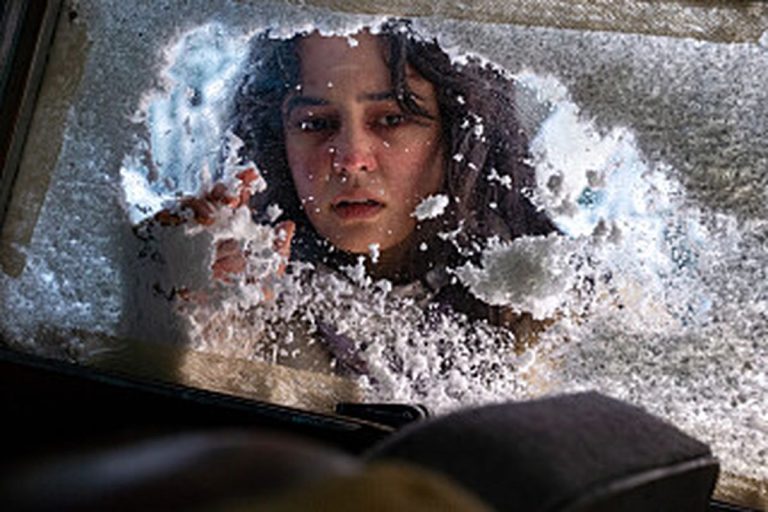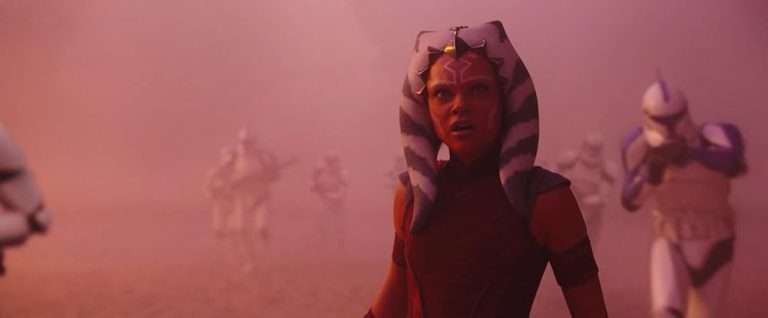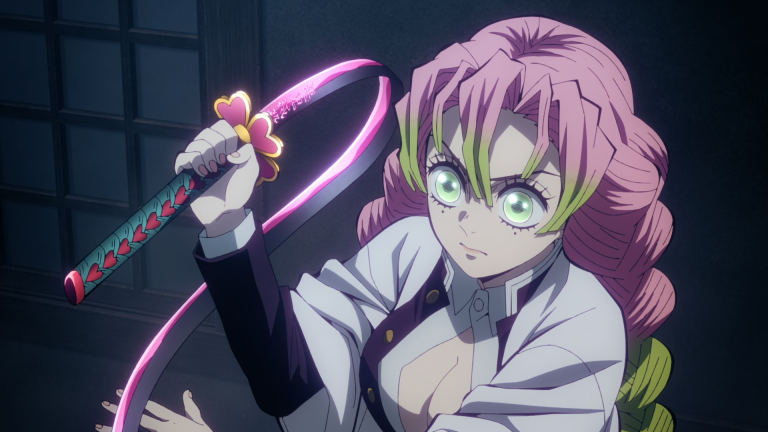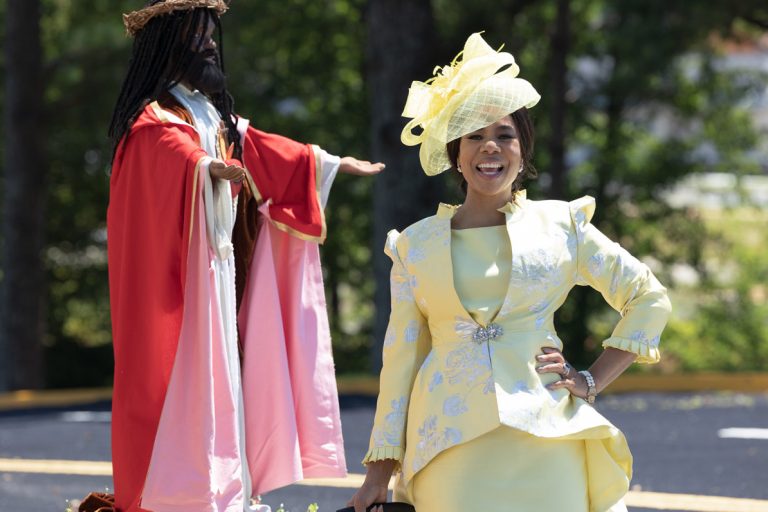Planet of the Apes (1968) Movie Explained: Planet of the Apes is one of the longest-running science-fiction franchises in cinematic history. Franklin J. Schaffner’s 1968 classic Planet of the Apes was loosely based on French novelist Pierre Boulle’s 1963 novel. Adapted by Twilight Zone fame Rod Serling (and co-written by Michael Wilson), the 1968 film presents a planet dominated by a primate civilization. It was a critical and commercial hit and was often credited for revolutionizing prosthetic makeup techniques. The Academy started conferring awards for Best Makeup and Hairstyling only from 1981. But for his groundbreaking work in Planet of the Apes (1968), John Chambers received an Honorary Academy Award (according to Wikipedia, 78 make-up artists worked in the film).
The original film’s success led to four sequels, which didn’t garner the critical acclaim of the first film but enjoyed blockbuster success. A live-action and animated television series was made in 1974 and 1975, respectively. In 2001, Tim Burton remade the original film, which was critically panned. A decade later, in 2011, Planet of the Apes got a reboot with the prequel series Rise of the Planet of the Apes. It was followed by Dawn, War, and Kingdom of the Planet of the Apes.
Recommended: 12 Monkeys (1995) Movie Ending, Explained & Themes Analyzed
Starring Charlton Heston, Roddy McDowall, and Kim Hunter, Schaffner’s Planet of the Apes (1968) deals with themes of identity, race, faith, and animal rights. Apart from extraordinary make-up effects and production design, the film features a remarkable and distinct musical score by Jerry Goldsmith. Now, let’s discover what happens in this not-so-subtle yet entertaining allegory of American society.
Spoilers Ahead.
Planet of the Apes (1968) Plot Explained:
Mission to Nowhere?
Planet of the Apes (1968) opens with astronaut George Taylor (Charlton Heston) recording his mission report before putting himself into cryosleep. Six months have passed since Taylor and his crew of three – Landon (Robert Gunner), Dodge (Jeff Burton), and Stewart – have been sent on a spacecraft traveling near light speed to a planetary system that is hundreds of light-years away. We don’t get any clear-cut details about the crew’s mission. Taylor, wearing an expression that reeks of ‘American Exceptionalism, ’ smokes a cigar and muses about the different breed of humans who might be receiving his message on Earth.
The interstellar spacecraft set, including the bunk-bed cryosleep chamber, looks rudimentary and implausible, resembling the ones from Hollywood sci-fi movies of the era. The outer space during this voyage looks like the screensaver running on a giant TV screen. Considering the energy and budget spent on conceiving the ape world, this basic space journey sequence has its own pulpy charm. Interestingly, a movie that was released more than a month after Planet of the Apes (1968) would redefine the on-screen portrayal of interstellar space and its complications. The then 40-year Stanley Kubrick made this film titled 2001: A Space Odyssey (1968).
Where Did the Astronauts Crashland?
The spacefarers wake up after splash-landing on a seemingly desolate and lifeless planet. Only three wake up from the deep sleep. The female astronaut Stewart has passed away due to a possible malfunction in her chamber. Once the spacecraft gets flooded, they get away in a raft. Dodge reports the planet has a breathable atmosphere. But Landon couldn’t send the signal back to Earth. Before abandoning the spacecraft, Taylor sees that according to Earth time, it’s 25-11-3978. With a medical kit, food, and water supply that will last three days, they slowly make their way to a rocky shore. When Landon inquires where they are, Taylor says they are 320 light-years away from Earth. However, for the bearded astronauts, eighteen months have passed.
Taylor mentions how much time might have passed back on Earth and that it’s better to accept that time must have changed their planet in an unrecognizable manner. While Taylor is a confident and cynical man, Landon is an optimist. Before leaving the rocky shore, Landon plants a small American flag. Taylor can only laugh at this gesture. The arduous journey through the desert landscape seems never-ending. While walking through a dry plateau, they witness bolts of lightning and thunder, but there’s no rain. The astronauts are also confused that the planet has a ‘strange luminosity,’ yet it doesn’t seem to have a moon.
Is There any Life on the Planet?
Landon still wonders about their location in the cosmos. Reading this as Landon’s preoccupation to make the return journey, Taylor once again reiterates the need to accept reality and live in the present. Furthermore, Taylor accuses Landon of being a ‘glory seeker’ who sees everything as an achievement of the human spirit. He also mocks him by saying there might be a life-sized bronze statue of Landon somewhere on Earth, giving him his cherished immortality.
Landon counters Taylor by questioning what his deal is. While Dodge is a pragmatist and a man of science, Landon wonders why Taylor volunteered for the mission since he is no seeker and vehemently despises humankind. Chomping on a cigar, Taylor states he is also a seeker — one who is seeking if there is something better than a man. Subsequently, Dodge, walking ahead, directs their attention to a plant he has found in a rocky terrain. Relieved that there’s life on the planet, the three continue their long walk. They move from the flat plateau to the rocky formations. Unbeknownst to them, someone – humanoid in appearance – is following them from the hills above.
Finally, Taylor, Landon, and Dodge stumble upon a relatively lush area whose clifftop borders are marked by a long row of strange things (made of animal pelts), which Landon calls ‘scarecrows.’ After climbing the cliff, Taylor sees a tree and runs into a fertile region to find a fresh waterfall. They strip down, bathe, and savor the pleasing sight of an oasis. Soon, Landon discovers human-sized footprints in the wet sand near the pool. In the distance, they see their clothes and stuff taken away by someone. After briefly walking through the shrubland, the three find their clothes ripped, and the pieces of equipment lie scattered.
The Spacefarers’ Rendezvous with the Planet’s Dominant Species
The astronauts reach an open cornfield, where the planet’s humans – clothed in animal skins – gather fruits from a nearby tree and munch on raw maize. Taylor is thankful that the primitive hominins are mute and seemingly harmless. A beautiful black-haired woman (Linda Harrison) captures Taylor’s attention. Moreover, Taylor perfectly thinks like an American as he feels if these are the intelligent and dominant species on the planet, they can be its rulers in six months’ time. But the next moment, all the meek and primitive humans of the planet freeze in their place, petrified by something.
Carrying the food, they instinctively run out of the field. The astronauts also run behind them. In the field, from the other side, long sticks are poking above the plants and flushing out the humans in the field. Guns are fired, and Taylor cowers to see a group riding in horses. Hiding in the field, Taylor sees that the ones riding the horses are a cavalry of uniformed gorillas. Before processing this shocking evolution, Taylor sees humans getting caught in various nets and traps.
Dodge gets shot and killed, whereas Landon is beaten and captured in a net. Taylor is shot in the throat while trying to get down an embankment. Some of the captured humans are strung up by their feet; the rest, including an unconscious Taylor, are put in a horse-drawn cage. The militant gorillas snap a victory picture (using an old tripod camera) by standing in front of the dead and piled-up humans.
What Is the Social Structure of the Ape Society?
The narrative cuts to the ape town, populated with monolithic buildings with weird-looking causeways and arches. Now, we are introduced to one of the central simian characters: Dr. Zira (Kim Hunter), a psychologist and a veterinarian. The ‘strange robe’ of Taylor catches her attention. He is getting a blood transfusion from the black-haired woman he saw in the field and getting treated for his wound. A fellow doctor and surgeon, Dr. Galen, rants about how humans are dirty animals and carry diseases. Taylor is awake, but the wounded astronaut can’t speak due to the wound, and since the humans on the planet haven’t developed speech, there’s nothing to differentiate him from the rest.
Dr. Zira and Dr. Galen are Chimpanzees, and their conversation reveals a hierarchy within a primate civilization. It seems the chimpanzees don’t have any real authority in the society. Since Dr. Zira is getting space and equipment for her project, Dr. Galen insists she put in a good word for him with the high command. The exchanges between the two chimpanzee doctors also reveal that the humans are being used as specimens for experimental brain surgery.
Later, Taylor is locked in a cage lined with straws. Dr. Zira visits Taylor in his cage and calls him ‘Bright Eyes.’ His attempts to form words surprise the doctor. When Zira takes out a pen and a small pad to note something, he signs her to come close. But when Taylor tries to grab the pen, the jail-keeper, Julius, pushes him back to the far end of the cage. Subsequently, the orange-bearded Orangutan, Dr. Zaius (Maurice Evans), makes his entrance to see Dr. Zira’s cherished animal specimen.
The Fundamentalist Beliefs of the Apes
Dr. Zaius is the ape community’s Minister of Science and Chief Defender of Faith – an inherently contradictory position as he does more to stringently uphold the faith than contribute to the science. The ape masses are indoctrinated to believe in the ancient scrolls (similar to Hebrew and Biblical teachings), said to be handed over by a Godly figure referred to as “The Lawgiver.” Dr. Zaius and his group of powerful orangutans tolerate science as long as it doesn’t question their faith’s sacredness and divinity. They are the indisputable gatekeepers of knowledge in the ape town.
When Taylor once again tries to speak in Dr. Zaius’s presence, the esteemed doctor calls it a mimicry and frowns at the idea of a ‘man acting like an ape.’ Dr. Zira wonders if this particular human can understand what they are speaking. But. Dr. Zaius authoritatively declares that he only supports experimental brain surgeries on humans. He deems Dr. Zira’s human behavioral studies as futile. Like the scientists of a bygone era on Earth, Dr. Zaius is of the opinion that an intelligent species can’t learn anything from animals.
Naturally, his idea of what constitutes intelligence is very myopic. Dr. Zaius’ profound contempt for humans is apparent from his call for total extermination of the race. After Dr. Zaius’ takes leave, Dr. Zira offers ‘Bright Eyes’ a present: the black-haired woman whom Taylor later names Nova. She is put in Taylor’s cage for mating purposes, which can further help with Zira’s studies.
Did Bright Eyes, aka Taylor, Communicate with Dr. Zira?
Dr. Zira meets her fiance, a chimpanzee archaeologist, Dr. Cornelius (Roddy McDowall). Zira takes him to show ‘Bright Eyes’ at the larger, enclosed cage outside. Dr. Zaius also arrives at the place and cautions Cornelius about his expedition ambitions. The ape society is laid on the foundation of ancient scrolls, and the lore says there was nothing before the Lawgiver’s days. Hence, Cornelius’ attempts to figuratively and literally dig into the ancient past can challenge their beliefs.
While Zira, Cornelius, and Dr. Zaius are communicating with each other, Taylor tries to write something in the dirt (“I CAN WRITE”). But when Nova tries to wipe off the words, he pushes her. It provokes another primitive man to fight with Taylor. The gorilla guards rush into the cage and restrain Taylor with a painful neck strap. As Dr. Zaius walks away, he sees a part of the word ‘Write’ and freezes in place, but he rubs it off, deliberately choosing to ignore the man’s intelligence.
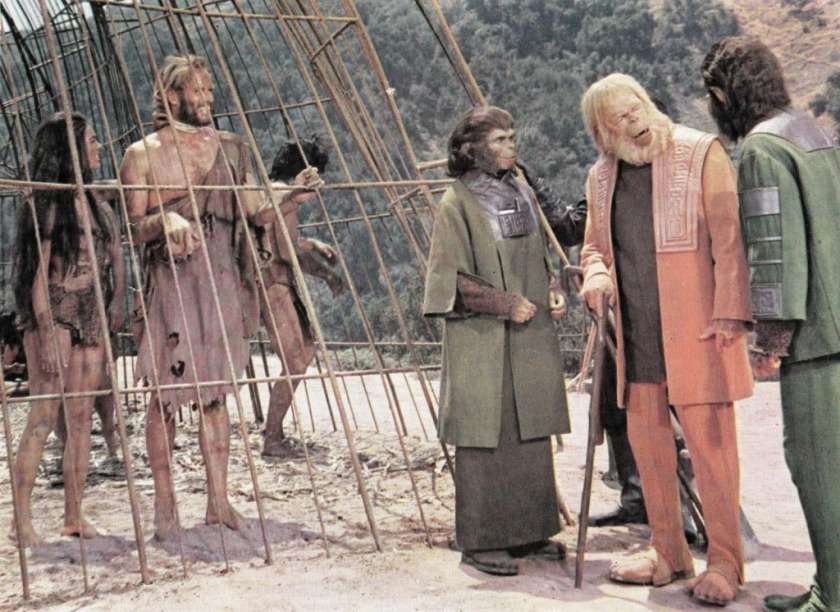
Back in the dirty, straw-strewn indoor cage, a sympathetic Dr. Zira gets close to her ‘Bright Eyes.’ Taylor grabs her pen and paper. The guards once again beat him down and give her back the paper. Dr. Zira is shocked to read what’s written: My NAME IS TAYLOR.” Immediately, Dr. Zira orders the guard to get a leash and release Taylor from the cage. Zira calls up Cornelius, and the latter, despite holding the evidence in front of his eyes, finds it hard to believe that a man can write. The fact that Taylor came from another planet sounds even more implausible to Cornelius.
Why Cornelius Finds Taylor’s Story Absurd?
The idea of space travel and the suggestion that an object could fly sound foolish to the apes. Their society seems medieval in composition. At the same time, they have invented guns and photographic equipment and are about to revolutionize surgical methods. Yet, the notion of flight is meaningless to them. Taylor further astounds them with his demonstration of flight through a paper airplane.
Then, Taylor writes to ask, “What happened to Landon?” The possibility of another speaking human fallen from the sky seems more exciting for Zira and Cornelius. Taylor also questions if they have maps. Cornelius shows Taylor a map, pointing out where they are and where he was captured. Taylor points to the water bodies and signs that their spacecraft crashed there, and they marched across the desert for days and nights. Cornelius once again finds this impossible. The ape society calls everything beyond the scarecrow-like markers the ‘Forbidden Zone.’ Except for Cornelius’ officially sanctioned trip into the zone for archaeological study, no one is allowed to go there. It’s the common belief that nothing can survive there for a prolonged period.
What is Cornelius’s Theory?
At this point, Dr. Zira posits that Taylor’s existence is the proof Cornelius is seeking for his theory. His theory is that apes evolved from a ‘lower’ order of primates, possibly humans. Since Cornelius has already found traces of a culture that predates the ancient scrolls, Dr. Zira wonders if Taylor is a ‘mutation’ or the ‘missing link’ in the evolution between humans and apes. Frustrated that both Zira and Cornelius are not receptive to his spacefarer identity, Taylor writes he is not the missing link in this topsy-turvy civilization.
Despite being a member of the scientific community, Cornelius isn’t ready to challenge the authority and risk his life. On the other hand, Zira naively believes the rulers will gladly accept the scientific truth once they have proven it beyond reasonable doubt. In the middle of their debate, Dr. Zaius barges in with Dr. Maximus (Woodrow Parfrey), the Commissioner of Animal Affairs. Dr. Zaius looks at the paper airplane, and when Zira says, ‘it floats in the air,’ he calls it ‘nonsense’ and commands the guards to put Taylor back in the cage.
Taylor Speaks, Finally!
After some time, the guard, Julius, is ordered to take Taylor for surgery. Taylor hears this and understands he will be killed soon if he doesn’t use the opportunity to flee and find Dr. Zira. Taylor swiftly overpowers the guard, Julius, and runs outside. The apes express disgust and horror at the human running in their streets. Taylor passes through a temple, where an Orangutan priest stands in front of the Lawgiver statue and preaches to his congregation about the significance of the scrolls. Then Taylor moves into a crude natural history museum set-up, where taxidermied humans are exhibited. Dodge, with glazed eyes, is also displayed there. Taylor is caught in a net after a prolonged chase. Just as the guard tries to take him away, a defiant Taylor roars, “Take your stinking paws off me, you damn dirty ape!” The gathered apes are stunned to silence.
Back in the indoor cage, Nova is separated from Taylor. He speaks of yearning for a companion and his inability to find love, which is why he left Earth. Taylor wonders if Nova can ever love him. At this point, Nova imitates Taylor’s smile. The guards arrive, use the neck restraint, and take Taylor to an ad-hoc tribunal. The trial is presided over by the three powerful Orangutans, including Dr. Zaius and Dr. Maximus. Dr. Honorius (James Daly), the Deputy Minister of Justice, appears as the state prosecutor before the tribunal.
What’s the Purpose of the Tribunal?
The trial is simply to indict Dr. Zira and Dr. Cornelius for heresy. The man, as Honorius says, has no rights since he doesn’t come under the ape law. When Taylor tries to defend himself, the gorilla bailiffs are ordered to silence him. The prosecutor talks about sacred truth and faith, reflecting the 1925 Scopes or Monkey Trial Case (which is the basis of Stanley Kramer’s 1960 courtroom drama Inherit the Wind), where a teacher was arrested and tried by a jury for teaching Darwin’s evolution theory. Prosecutor Honorius accuses Dr. Zira of creating the ‘speaking monster’ through her experiments.
The Kangaroo court proceedings continue with the prosecutor trying to test Taylor in the dogmas of ape society. Reasoning and intellect are strictly limited to the knowledge of ancient scrolls. Hence, the prosecutor declares the man doesn’t have the ability to think or reason. When Taylor tries to pass a message to the judges about his space exploration mission, they find it to be a poor joke. Taylor retorts that there is another man like him, captured during the hunt. He requests them to take him to Landon.
What Happened to Landon?
The tribunal agrees to take a look at the captured humans to find Landon. Taylor is taken outside, and he finds Landon among a group. But Landon doesn’t acknowledge Taylor’s calls. On closer look, it’s obvious a lobotomy was performed on Landon. An enraged Taylor tries to attack Dr. Zaius. But he is restrained and taken back inside, where Dr. Zaius explains that Landon is a victim of a skull fracture and their doctors saved his life by operating on him. When Taylor accuses Dr. Zaius of harming Landon, the guards are ordered to gag Taylor.
Also, Read: Looper (2012) Movie Explained & Theme Analysed
At this point, Cornelius broaches his theory that Taylor might have come from the Forbidden Zone. He comes to this conclusion since Taylor has accurately described the region. But when Cornelius speaks of an ancient culture before the time of sacred scrolls, he is loudly objected. However, Dr. Zira strongly expresses her belief in scientific discoveries as the three tribunal officials hilariously take the position of ‘Three Wise Monkeys.’ Finally, the prosecutor charge Zira and Cornelius with contempt of tribunal and scientific heresy. The tribunal is adjourned, and both the accused scientists are temporarily freed on bail.
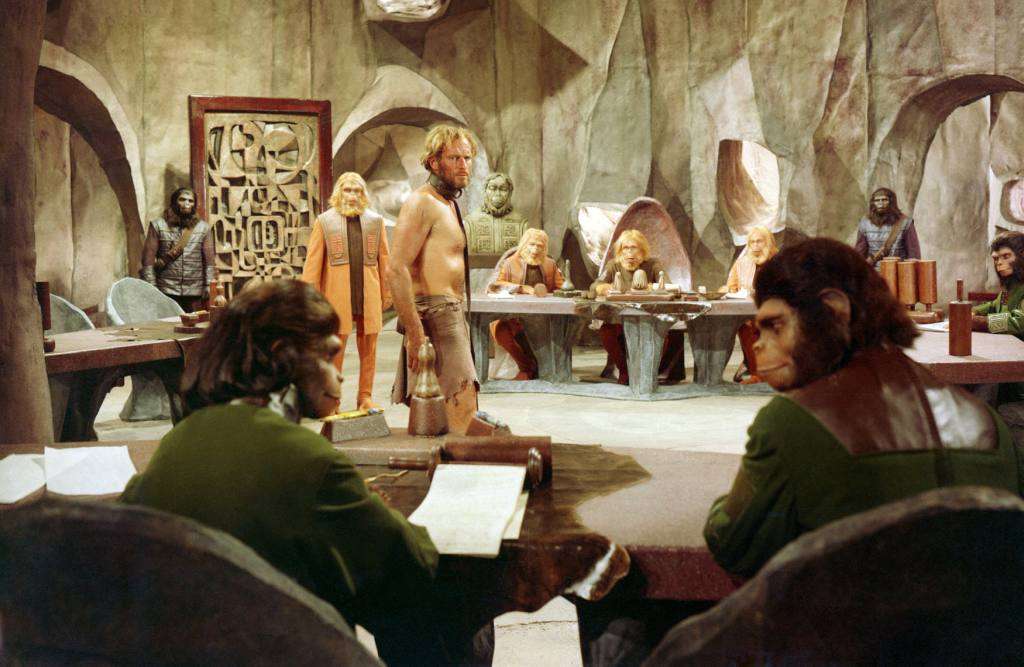
Screenwriter Michael Wilson worked on Rod Serling’s initial draft for Planet of the Spes (1968). He was blacklisted for his alleged involvement in Communist politics and after refusing to answer the questions of HUAC (House Un-American Activities Committee). Wilson was the screenwriter of the great American workers’ cinema Salt of the Earth (1954). He also collaborated on the scripts of David Lean’s classics, Bridge of River Kwai (1957) and Lawrence of Arabia (1962), but was denied credit for decades. Apart from transplanting many injustices from the American system to a militaristic ape community, Wilson’s draft has particularly zeroed in on the outrageous practices of HUAC through the film’s incredible trial scene.
What’s the Reason behind Dr. Zaius’s fear?
After the trial, Taylor is brought to Dr. Zaius’s private quarters. Zaius threatens to convict Zira and Cornelius for heresy and perform an experimental surgery on Taylor. To avoid such a living death, Zaius asks Taylor to tell the truth about where he came from. The notion of Taylor belonging to an intelligent human race, living beyond the Forbidden Zone, sounds more likely to Zaius than the story of an alien visitor from the solar system. Dr. Zaius confesses that he believes in Zira and Cornelius’ hypothesis, i.e., Taylor is a mutant. Taylor questions if, suppose, he belongs to a mutant race of humans, why does the emergence of one such man frighten Dr. Zaius? To which Zaius bitterly replies, “Because you’re not unique. There’s the one you call Landon.”
Earlier in the narrative, when Taylor is enclosed in an expansive cage on the outside, Zira mentions to Cornelius that something is bothering Dr. Zaius, and he has been around the lab for the last two days. If we can relate Dr. Zira’s statement to Landon’s lobotomy, it’s evident that Dr. Zaius did know of Landon and his ability to speak. After ordering to perform surgery on Landon, Zaius was on the lookout for anyone similar to Landon. When Dr. Zira speaks of her ‘Bright Eyes’ and his effort to form words, it further frightens Zaius. He thinks a tribe of humans like Taylor and Landon, living in the jungle on the other side of Forbidden Zone, might invade the ape town.
The Journey back to the Forbidden Zone
At this moment, it also becomes clear that Dr. Zaius and the powerful Orangutans simply use the sacred scrolls’ dogma to hide some secret about their species’ past. He doesn’t want Zira and Cornelius to discover things that might rewrite the ape’s history. When the gorilla guards take away Taylor, he demands, “What are you afraid of, doctor”? Back at the cage, a chimpanzee smartly subdues Julius, the guard, and sets Taylor free. The chimpanzee is Dr. Zira’s teen nephew, Lucius (Lou Wagner). Taylor demands to take Nova with him, too. Dr. Zira intercepts them, and they all leave the town in a horse-drawn cart. Once they get out of the town, Cornelius meets them with horses. Always an American, the first thing Taylor takes for his upcoming journey is a gun.
Zira and Cornelius decide to venture into the Forbidden Zone to find more proof for his hypothesis. Taylor also accompanies them, leaving behind the ‘scarecrow’ marked borders of the ape community, and follows the Dead Sea to reach a dig site. Upon reaching the dig site near the seashore, Taylor shaves his beard. Nova, alongside Cornelius and Lucius, is curious about this strange act. Cornelius tells him without the beard, he looks ‘less intelligent.’ Just as they are about to climb the makeshift ramparts into the cave diggings, Dr. Zaius arrives with his guards.
Planet of the Apes (1968) Movie Ending Explained:
What do They Learn from the Archaeological Excavations?
Taylor threatens to shoot Dr. Zaius and asks the guards to lower their guns. Zaius warns Zira and Cornelius to return with him since the sentence for heresy is a maximum of two years. But pointing guns might be interpreted as treason, and they will hang for it. Taylor challenges Zaius to visit the cave that contains fossils and ancient artifacts. If there’s enough evidence about an ancient culture, he asks Zaius to set his friends free. Zaius accepts the challenge, and Lucius is asked to stay outside and take guard.
After entering the cave, Cornelius mentions the primitive ape culture he found through the diggings, which dates back approximately 1,300 years. The crude cutting tools and fossils of gorillas were found at one level of digging. But another level of excavation reveals an even ancient culture, which is more advanced than the earliest ape culture and one with a knowledge of metallurgy. Cornelius says he has enough evidence to support his paradoxical findings. He also presents a talking human baby doll found near a man’s jawbone. Among the ‘strange artifacts’ Cornelius couldn’t identify, Taylor singles out false teeth and broken eyeglasses. Dr. Zaius calls all this a lunacy. He affirms no intelligent life existed before the ape civilization emerged 1,300 years ago.
Why does Dr. Zaius Despise Humankind?
Dr. Zira and Cornelius hear a disturbance outside and see Lucius getting attacked by Zaius’ guards. A gunfight ensues, and after shooting down a gorilla guard, Taylor once again threatens Zaius at gunpoint. Zaius orders his guards to withdraw. Taylor decides to leave with Nova and explore the planet. Zaius questions Taylor: if humankind on this planet were once superior, why did they perish? Taylor says a lot of unique things could have happened, from meteor showers to a widespread plague. Taylor understands Dr. Zaius has always known about an ancient human culture that’s more advanced than the present ape society. He says Zaius is a ‘Defender of the terrible secret,’ rather than a ‘Guardian of faith.’
In response, Dr. Zaius asks Cornelius to read a verse from his scroll, which warns about human greed and lust for conquering. Dr. Zaius believes it doesn’t matter if there was an advanced human culture in the past. As the scrolls passed over for generations say, apes must always be wary of humans and keep them in control, or else humans will destroy them.
Taylor kisses Dr. Zira goodbye, which she reluctantly accepts after declaring, ‘You’re so damned ugly.’ As Taylor leaves the place, Dr. Zaius once again delivers a polemic on the pestilent humankind. The doctor says the Forbidden Zone was once a paradise, and it was the human race that turned into a desert. Taylor believes there must be an answer to what happened to humans on the planet and why apes evolved from them. Dr. Zaius warns him about his quest, asserting, “You may not like what you find.”
What’s Out There?
Once Taylor and Nova are gone, Dr. Zaius commands his guards not to pursue them. He also says Zira and Cornelius will stand trial for heresy. When Cornelius protests and talks about the proofs, Zaius cuts him off and proclaims there will be none. The guards place explosives and blast it to seal the cave. When Dr. Zira wonders what will Taylor find out there, Dr. Zaius forlornly replies, “His Destiny.”
At last, Taylor enjoys his freedom with Nova. After a while, they come across a structure on the beach. Taylor gets off the horse and stands still. He agonizingly utters, “Oh, my God.” Finally, he has the epiphany that all this time, he has been ‘home.’ As the film ends, Taylor’s parting words to us: “You maniacs! You blew it up! Goddamn you all to hell!” The camera zooms out to reveal the half-buried ‘Statue of Liberty.’ Planet of the Apes (1968) leaves us with an ending that’s hopeless, even for a cynic like George Taylor.
The Unforgettable Ending of ‘Planet of the Apes’ (1968)
Hollywood sci-fi has always persistently served hope, even in the galaxies-spanning saga of Star Wars or Marvel Cinematic Universe. In recent times, Mark Watney in Ridley Scott’s Martian (2015) comes across as the perfect on-screen American hero, surviving despite the insurmountable odds stacked against him. Even in the morally corrupted, post-apocalyptic landscape of Mad Max: Fury Road (2015), its oppressed characters clung to hope. But Schaffner’s Planet of the Apes (1968) ends with the reckoning of human failures. The Statue of Liberty, a beacon of hope in American culture, is reduced to a symbol of a lost civilization. Moreover, the note of despair in Taylor’s voice feels more relevant than ever. Made in the middle of the Cold War, the fear over the reasons for human-induced apocalypse has changed (from nuclear war to climate change), but the threat of annihilation remains the same.
Planet of the Apes (1968), though, answers the fate of the planet’s (which is none other than Earth) humans; the topic of ape evolution was answered only in the reboot series Rise of the Planet of the Apes (2011). But the more interesting question would be, in light of Taylor’s final discovery: how did the astronauts travel eighteen months (near) the speed of light only to return to Earth? The movie version was only loosely based on Boulle’s 1963 novel, which has a different narrative framing device and a final twist that can only work in novels. There’s not an answer to this question there. Therefore, in the end apart from lamenting about Taylor’s fate, we are left wondering about the kind of navigation technology used in the interstellar spacecraft.
Overall, Planet of the Apes (112 minutes) provides a compelling movie experience with one of cinematic history’s most famous final imagery.




